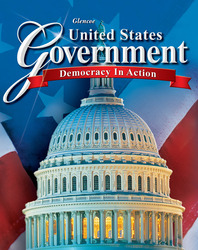United States Government: Democracy in ActionUnit 6:
Participating in GovernmentBig Idea Activity — Lesson Plan <a onClick="window.open('/olcweb/cgi/pluginpop.cgi?it=jpg::::/sites/dl/free/0078799821/680642/big_idea.jpg','popWin', 'width=NaN,height=NaN,resizable,scrollbars');" href="#"><img valign="absmiddle" height="16" width="16" border="0" src="/olcweb/styles/shared/linkicons/image.gif"> (10.0K)</a> <a onClick="window.open('/olcweb/cgi/pluginpop.cgi?it=jpg::::/sites/dl/free/0078799821/680642/big_idea.jpg','popWin', 'width=NaN,height=NaN,resizable,scrollbars');" href="#"><img valign="absmiddle" height="16" width="16" border="0" src="/olcweb/styles/shared/linkicons/image.gif"> (10.0K)</a>
Does the election process result in the best leaders in office?
Assignment: Conduct a Campaign
Students will conduct a campaign and hold an election for president of the classroom. Assignment Task List
Step 1: Review with students the factors that influence voters' decisions. Have them complete the chart below with details about each factor.  <a onClick="window.open('/olcweb/cgi/pluginpop.cgi?it=jpg::::/sites/dl/free/0078799821/680643/iwb_logo.jpg','popWin', 'width=NaN,height=NaN,resizable,scrollbars');" href="#"><img valign="absmiddle" height="16" width="16" border="0" src="/olcweb/styles/shared/linkicons/image.gif"> (8.0K)</a> Project the chart from <a onClick="window.open('/olcweb/cgi/pluginpop.cgi?it=jpg::::/sites/dl/free/0078799821/680643/iwb_logo.jpg','popWin', 'width=NaN,height=NaN,resizable,scrollbars');" href="#"><img valign="absmiddle" height="16" width="16" border="0" src="/olcweb/styles/shared/linkicons/image.gif"> (8.0K)</a> Project the chart from  page 50
(46.0K)
of the Chapter Summaries onto the whiteboard. Use the screen tool to reveal one row of answers at a time. page 50
(46.0K)
of the Chapter Summaries onto the whiteboard. Use the screen tool to reveal one row of answers at a time.
Five Major Factors that Influence Voters' Decisions | Personal Background | (See answers on the Chapter Summary chart, page 50.) | Loyalty to a Political Party | | Campaign Issues | | The Voter's Image of the Candidate | | Propaganda | |
 <a onClick="window.open('/olcweb/cgi/pluginpop.cgi?it=jpg::::/sites/dl/free/0078799821/680642/BL.jpg','popWin', 'width=NaN,height=NaN,resizable,scrollbars');" href="#"><img valign="absmiddle" height="16" width="16" border="0" src="/olcweb/styles/shared/linkicons/image.gif"> (0.0K)</a> <a onClick="window.open('/olcweb/cgi/pluginpop.cgi?it=jpg::::/sites/dl/free/0078799821/680642/BL.jpg','popWin', 'width=NaN,height=NaN,resizable,scrollbars');" href="#"><img valign="absmiddle" height="16" width="16" border="0" src="/olcweb/styles/shared/linkicons/image.gif"> (0.0K)</a>  <a onClick="window.open('/olcweb/cgi/pluginpop.cgi?it=jpg::::/sites/dl/free/0078799821/680642/ELL.jpg','popWin', 'width=NaN,height=NaN,resizable,scrollbars');" href="#"><img valign="absmiddle" height="16" width="16" border="0" src="/olcweb/styles/shared/linkicons/image.gif"> (1.0K)</a> Differentiated Instruction <a onClick="window.open('/olcweb/cgi/pluginpop.cgi?it=jpg::::/sites/dl/free/0078799821/680642/ELL.jpg','popWin', 'width=NaN,height=NaN,resizable,scrollbars');" href="#"><img valign="absmiddle" height="16" width="16" border="0" src="/olcweb/styles/shared/linkicons/image.gif"> (1.0K)</a> Differentiated Instruction <a onClick="window.open('/olcweb/cgi/pluginpop.cgi?it=jpg::::/sites/dl/free/0078799821/680643/iwb_logo.jpg','popWin', 'width=NaN,height=NaN,resizable,scrollbars');" href="#"><img valign="absmiddle" height="16" width="16" border="0" src="/olcweb/styles/shared/linkicons/image.gif"> (8.0K)</a> To review with below-level students and English-language learners, project the chart from <a onClick="window.open('/olcweb/cgi/pluginpop.cgi?it=jpg::::/sites/dl/free/0078799821/680643/iwb_logo.jpg','popWin', 'width=NaN,height=NaN,resizable,scrollbars');" href="#"><img valign="absmiddle" height="16" width="16" border="0" src="/olcweb/styles/shared/linkicons/image.gif"> (8.0K)</a> To review with below-level students and English-language learners, project the chart from  page 51
(70.0K)
of the Chapter Summaries onto the whiteboard. Ask a student to come to the board and move the answers into the correct column. (This calls for whole-class participation. The student marks the answers that the majority calls out.) page 51
(70.0K)
of the Chapter Summaries onto the whiteboard. Ask a student to come to the board and move the answers into the correct column. (This calls for whole-class participation. The student marks the answers that the majority calls out.)
|
Step 2: Organize the class into two political parties. Prepare an equal number of "Democrat" and "Republican" slips ahead of time (or make up fictional party names). Put the slips into a hat, and have each student draw a slip to determine their party affiliation. Step 3: Students will gather into their political parties and summarize their party's position on the following issues: (1) aid to the poor; (2) responsibilities of the United States to the rest of the world; and (3) socialized healthcare. (You may provide alternative issues or ask the parties to create their own issues.) The summary of their positions on these issues will become their party platform. Step 4: Students will hold a closed primary election within their party to decide the party's candidate for the "general" election. Before doing so, ask them to summarize the methods of nominating a party candidate in a chart like the one below. Then have party members cast their ballots for the candidate. Candidate Selection Method | Description | Caucus | A private meeting of party leaders. In the 1830s, complaints that caucuses were undemocratic led to the adoption of nominating conventions. | Nominating Convention | An official public meeting of a party to choose candidates for office. | Direct Primary | An election in which voters select candidates to run in the general election. |
Step 5: Have parties campaign for their candidate. Ask party leaders to schedule stump speeches throughout the school (during lunch, between class changes, after school, at school events). Provide materials for students to create and distribute paper buttons, ribbons, and pamphlets with their party's platform. Tell students to schedule a debate between the two candidates and to utilize propaganda.  <a onClick="window.open('/olcweb/cgi/pluginpop.cgi?it=jpg::::/sites/dl/free/0078799821/680642/BL.jpg','popWin', 'width=NaN,height=NaN,resizable,scrollbars');" href="#"><img valign="absmiddle" height="16" width="16" border="0" src="/olcweb/styles/shared/linkicons/image.gif"> (0.0K)</a> <a onClick="window.open('/olcweb/cgi/pluginpop.cgi?it=jpg::::/sites/dl/free/0078799821/680642/BL.jpg','popWin', 'width=NaN,height=NaN,resizable,scrollbars');" href="#"><img valign="absmiddle" height="16" width="16" border="0" src="/olcweb/styles/shared/linkicons/image.gif"> (0.0K)</a>  <a onClick="window.open('/olcweb/cgi/pluginpop.cgi?it=jpg::::/sites/dl/free/0078799821/680642/OL.jpg','popWin', 'width=NaN,height=NaN,resizable,scrollbars');" href="#"><img valign="absmiddle" height="16" width="16" border="0" src="/olcweb/styles/shared/linkicons/image.gif"> (0.0K)</a> Differentiated Instruction <a onClick="window.open('/olcweb/cgi/pluginpop.cgi?it=jpg::::/sites/dl/free/0078799821/680642/OL.jpg','popWin', 'width=NaN,height=NaN,resizable,scrollbars');" href="#"><img valign="absmiddle" height="16" width="16" border="0" src="/olcweb/styles/shared/linkicons/image.gif"> (0.0K)</a> Differentiated Instruction <a onClick="window.open('/olcweb/cgi/pluginpop.cgi?it=jpg::::/sites/dl/free/0078799821/680643/iwb_logo.jpg','popWin', 'width=NaN,height=NaN,resizable,scrollbars');" href="#"><img valign="absmiddle" height="16" width="16" border="0" src="/olcweb/styles/shared/linkicons/image.gif"> (8.0K)</a> Project the chart on page 496 of the StudentWorks Plus Online onto the whiteboard. Help students provide real-life examples of each type of propaganda. <a onClick="window.open('/olcweb/cgi/pluginpop.cgi?it=jpg::::/sites/dl/free/0078799821/680643/iwb_logo.jpg','popWin', 'width=NaN,height=NaN,resizable,scrollbars');" href="#"><img valign="absmiddle" height="16" width="16" border="0" src="/olcweb/styles/shared/linkicons/image.gif"> (8.0K)</a> Project the chart on page 496 of the StudentWorks Plus Online onto the whiteboard. Help students provide real-life examples of each type of propaganda.
|
Step 6: Students will set up a bipartisan canvassing board to create ballots with nominees' names, set up posters explaining when and where to vote, and to register voters as they cast their ballots. After the polls close, the canvassing board will count the ballots. Step 7: Students will hold the election. During polling times, remind party members to remove posters and other political party propaganda from the classroom and school grounds.  <a onClick="window.open('/olcweb/cgi/pluginpop.cgi?it=jpg::::/sites/dl/free/0078799821/680642/big_idea.jpg','popWin', 'width=NaN,height=NaN,resizable,scrollbars');" href="#"><img valign="absmiddle" height="16" width="16" border="0" src="/olcweb/styles/shared/linkicons/image.gif"> (10.0K)</a> <a onClick="window.open('/olcweb/cgi/pluginpop.cgi?it=jpg::::/sites/dl/free/0078799821/680642/big_idea.jpg','popWin', 'width=NaN,height=NaN,resizable,scrollbars');" href="#"><img valign="absmiddle" height="16" width="16" border="0" src="/olcweb/styles/shared/linkicons/image.gif"> (10.0K)</a>
After the election, ask students to use information from the activity to write a short essay answering this question: Does the election process result in the best leaders in office?
 |  |






















